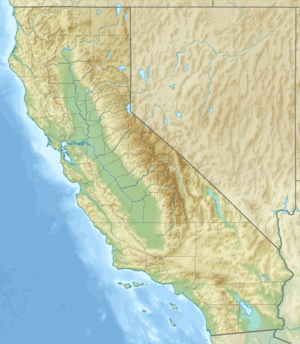Cañada de los Osos facts for kids
Quick facts for kids Cañada de los Osos |
|
|---|---|
| Country | United States |
| State | California |
| Region | Santa Clara County |
| Physical characteristics | |
| Main source | Kickham Peak 11.5 mi (20 km) east of Gilroy 1,920 ft (590 m) 37°02′10″N 121°23′037″W / 37.03611°N 121.39361°W |
| River mouth | Coyote Creek 7 mi (11 km) east of San Martin 830 ft (250 m) 37°04′21″N 121°28′42″W / 37.07250°N 121.47833°W |
| Length | 8 mi (13 km)confluence to mouth |
Cañada de los Osos is a stream about 8 miles (13 km) long. It flows through Santa Clara County, California in the United States. This stream is special because it's part of a protected area. It eventually joins a larger stream called Coyote Creek. This area is located in the Diablo Range, near Gilroy, California.
Contents
What's in a Name? The Valley of Bears
The name Cañada de los Osos comes from the Spanish language. It means "Valley of the Bears." This name suggests that bears might have lived in this area a long time ago!
Wildlife and Nature: A Special Reserve
Protecting Animals and Plants
The Cañada de los Osos Ecological Reserve is a large natural area. It covers about 5,800 acres. The California Department of Fish and Wildlife manages this reserve. It was officially named an ecological reserve in 2003. Before that, it was known as Stevenson Ranch.
Bringing Back Wildlife
For nearly 20 years, people have worked to restore this land. Now, you can find native grasses and trees like valley oaks. Many animals also live here. These include tule elk (Cervus canadensis nannodes) and pronghorn (Antilocapra americana). Long ago, thousands of cattle used to graze here.
A group of volunteers called The Friends of the Cañada de los Osos helps with this work. This group is led by Henry Coletto. He was a wildlife ranger and game warden. He helped bring elk and pronghorn back to Santa Clara County.
Helping Deer Thrive
The number of California mule deer (Odocoileus hemionus californicus) is growing in this reserve. More fawns (baby deer) survive here than in other parts of the Diablo Range. This is because of improvements made over the last 20 years.
For example, over 40 natural springs have been updated. Old watering troughs for livestock were removed. They were replaced with small, ground-level watering spots for wildlife. These "wildlife drinkers" provide clean, fresh water. This is much better than old ponds that can dry up or have dirty water in summer.



